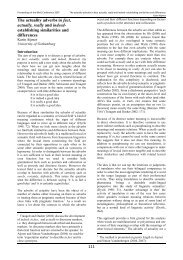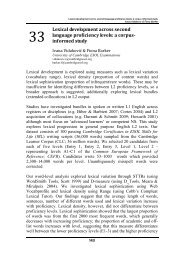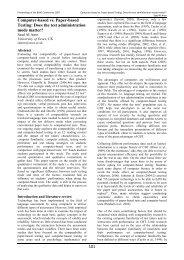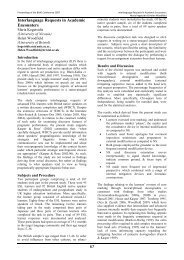Proceedings of the - British Association for Applied Linguistics
Proceedings of the - British Association for Applied Linguistics
Proceedings of the - British Association for Applied Linguistics
Create successful ePaper yourself
Turn your PDF publications into a flip-book with our unique Google optimized e-Paper software.
Measuring L2 English Phonological Pr<strong>of</strong>iciency: Implications <strong>for</strong> Language Assessment<br />
Evelina Galaczi, Brechtje Post, Aike Li and Calbert Graham<br />
(variability in <strong>the</strong> duration <strong>of</strong> consonantal intervals, normalised <strong>for</strong><br />
speaking rate) were used.<br />
The analysis was carried out with <strong>the</strong> speech processing s<strong>of</strong>tware Praat<br />
(Boersma & Weenink, 2010). An example <strong>of</strong> <strong>the</strong> segmental and prosodic<br />
labelling is given in Figure 12.1.<br />
Figure 12.1: Praat segmental and prosodic labelling: an example<br />
The first tier contains orthographic transcription. The second tier marks<br />
each syllable as unaccented (s), accented (sa), phrase-final (sef),<br />
accented/phrase-final (saef), or hesitated (sx). In <strong>the</strong> third tier, each vowel<br />
and consonant was segmented primarily by visual inspection <strong>of</strong> speech<br />
wave<strong>for</strong>ms and wideband spectrograms. This procedure was carried out<br />
with reference to standard criteria (e.g. Peterson & Lehiste 1960). The<br />
fourth tier contains <strong>the</strong> phrasing in<strong>for</strong>mation, i.e. beginning and end <strong>of</strong> an<br />
intonational phrase.<br />
Three annotators worked on <strong>the</strong> segmental and prosodic labelling <strong>of</strong> <strong>the</strong><br />
data, achieving an inter-coder agreement <strong>of</strong> 97%.<br />
69







